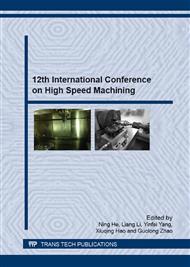p.509
p.522
p.529
p.536
p.545
p.552
p.562
p.570
p.578
Dynamic Grinding Hub Monitoring during a High Performance Grinding Process with Ceramic CBN on Cold Work Steel
Abstract:
Grinding is a material removing process with undefined cutting edges. The high numbers of grains participating during the chip formation are continuously subjected to non-uniform wear and topography changes. This behavior typifies a highly non-stationary process. Capturing the whole process in a simulation and predicting the work results is difficult. For this reason are In-process monitoring techniques a suitable approach to address this issue. In this paper a wireless In-process monitoring system is presented. The system is mounted on the grinding hub and detects the dynamic behavior of the wheel during the grinding process. A full bridge with strain gauges located close to the abrasive layer has been used to give instantaneous feedback concerning normal force and wheel deformation during each wheel revolution. This technique enables a continuously monitoring and improving of the grinding process, hence a more efficient and sustainable use of the abrasive layer. Experiment results are presented which demonstrate the ability of the ‘intelligent’ wheel to monitor grinding processes and to improve the machine performance.
Info:
Periodical:
Pages:
545-551
Citation:
Online since:
January 2016
Authors:
Price:
Сopyright:
© 2016 Trans Tech Publications Ltd. All Rights Reserved
Share:
Citation:


